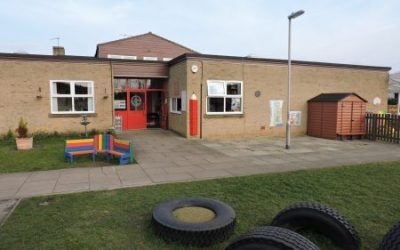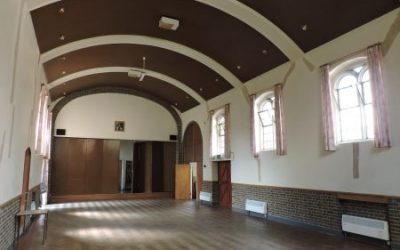St Andrews CofE Primary School.
Net Zero Carbon Project
St Andrews CofE Primary School, Chedworth was successful in obtaining a £120,000 grant through the government’s Public Sector Decarbonisation Scheme to transition to a Net Zero Carbon school by reducing its energy demand through LED lighting and insulation measures and then generating its heating and power through an air source heat pump and PV panels. The school was previously reliant on an oil boiler to provide its heating (being in a rural off gas location) and have now undertaken a complete conversion to the use of air (to water) source heat pumps and removed its end of life oil boiler and tank.
The works were completed by end of March 2021.
The project has resulted in the school being net zero carbon with its residual energy demand being met from a 100% renewable electricity supplier. The project will save 15.49 tonnes of CO2e per year and provide financial savings of £4,500 per year to the school.
The project was managed by Inspired Efficiency, who helped the school to obtain the funding which was administered through SALIX.
Project Details
The school had worked to reduce its environmental impact over the years and through a range of previous works that the school has carried out it had already moved its hot water away from the oil boiler to electric point of use units with timeclocks. It had changed around 50% of its lighting to LED over the past 5 years and had double glazed windows in around 70% of the school.
The net zero project aimed to reduce the heating and electricity demand of the school before then seeking to generate its remaining heating and power needs from renewable and decarbonised sources.
To reduce its demand, it has:
- Replaced its remaining single glazed windows (which could not close properly!) to double glazed well sealed units.
- Injected cavity wall insulation into the walls of 3 classrooms, where the school was extended in the 1970’s and where therefore unfilled cavity wall construction
- Added insulation beneath the suspended timber floors of the original Victorian school building
- Installed new suspended ceilings into two classrooms which had exposed ceilings. These have reduced the heated air volume of the classrooms as well as reducing draughts from the wall and roof junction
- Installed insulation above existing suspended ceilings to the staff room and other areas of the school which have a pitched roof above with no insulation.
The heating and electricity needs are then being decarbonised by:
- Installing an air source heat pump to entirely replace its old oil boiler which, along with the large oil tank, has been removed
- Installing a solar PV system on to the school halls roof to generate around 40% of the total new electricity demand from renewable sources. The PV panels will generate enough electricity to serve all of the schools lighting and small power needs (including hot water) and about 25% of the new ASHP. The solar PV has been installed with a 5kW battery to extend the useful power generation into the evenings.
Details of works
All of the LED lighting has been installed throughout the school including the main school hall which previously has T8 fluorescent lighting. The lighting works are forecast to reduce the lighting electrical usage by 64%, saving over £1,000 per year in electricity.
The air source heat pumps have been installed comprising of four 14kW Mitsubishi EcoDan units. These connect onto the existing heating system within the school that comprise of underfloor heating to the school hall and radiators to the classrooms and other areas. The system is set to run with a weather compensated 45°C max flow temp which has been proven to be successful at heating the school through a combination of the improved insulation and an increased optimised start time in the mornings. The system is turned off overnight and through weekends and holiday periods. A full case study on the ASHP can be view on the Mitsubishi website at St Andrews School – Chedworth – Document Library – Mitsubishi Electric
The existing boiler and oil tank have been removed and disposed of.
The controls, and distribution pumps for the new air source heat pump have been located in the existing boiler room of the school.
Adjustment and Challenges to Project
The incoming electricity supply has raised a few challenges. SSE had originally advised that 3 phase supply was available and could be installed for £300 connection fee. After the order was paced for this they then advised that the 3-phase was not available locally and there would be £18,500 of network reinforcement costs required to connect the school!
An alternative solution has been developed whereby a second single phase connection (which was already connected to the school) was re-energised (for no cost) and the specification of the heat pumps adjusted to a single phase rather than the 3 phase version. This has required some additional sub mains distribution in the school.
The knock on effect of this is that the original 40 panel PV system was too large to be connected to the two single phase supplies so the PV solution has been revised to a 30 panel solution, which is connected via a battery storage system, the battery storage allows for all 30 panels to be installed and linked to both supplies as well as giving additional benefits of spreading the generation over longer periods through the storage arrangements. The battery storage system also allowed for a fast track DNO approval route to be allowed, meaning the system could be connected into the grid in line with the funding programme.
The bureaucracy of the funding has also been a challenge with initial delays in the approval of the funding resulting in a late start to the project then frequent additional forms being required through the projects development. The release of the funding has been a highly significant issue as this is a long winded process and resulted in payments being processed with a delay of around 8 weeks.
Planning was required for the PV panels and the air source heat pumps as the school is in a conservation area. The school is not listed nor does the directly neighbouring property have any form of listing. It was of some frustration to note that the installation of an air source heat pump is not currently included as an allowable item under the permitted development rules and that the PV panels were considered as being facing a highway when the roof is round the side and back of the school. Fortunately, the planning application received a high level of public support and no objections and with the aid of local council members permission was granted just within the timescales required.
Additional Project Benefits
The project has generated additional benefits in that:
- The existing T5 lighting, which was removed for the new insulated ceilings and LED, still had good life left within the fittings and these were donated to the local Silver Band to replace their existing old and highly inefficient T12 lighting in the band room in the village.
- The project has inspired people to come forward and offer support and funding for other measures which will allow the school to install a EV charging point in the car park for staff (and out of hours community) use.
The project continues to build on the schools strong environmental actions such as being the community hub for Terracycle and battery recycling and having a long established, ‘no mow’ wildlife area.
PR and Community Engagement
The project has been announced to the community via social media platforms (NextDoor, Facebook and Twitter) where is has received unanimous and significant community support.
The project features in the Church of England’s national press release on 1 year on from its 2030 net zero carbon commitment One year on: Church moves forward on carbon reduction target | The Church of England and is also published on the Gloucester Diocese and central Church of England websites
The project was featured in BBC Radio Gloucestershire including an interview with Matt Fulford on Sunday 21st Feb.
The project has be published by the Sun Primary in sleepy rural village becomes Britain’s first net-zero school (thesun.co.uk) and local press Chedworth primary school to become one of the first net zero carbon schools in the country | Wilts and Gloucestershire Standard (wiltsglosstandard.co.uk)
The project has been published as a case study by Mitsubishi (https://les.mitsubishielectric.co.uk/case-studies/st-andrews-school-chedworth) and featured in Renewable Energy Installer https://www.renewableenergyinstaller.co.uk/2021/05/heat-pumps-key-to-achieving-energy-efficiency-in-retrofit-project/
Further PR and media work is planned around a launch of the project later in the year once COVID restrictions allow.
Latest Case Studies.
Funding for Energy Audits / Decarbonisation Advice
The recent announcement of the use of the £1bn funding to improve the energy efficiency of the public sector buildings has set a funding landscape for energy saving projects that has not been seen in the last 10 years…
Delivery of energy efficiency measures
Delivery of energy efficiency measures.07 JUL 2016[DISPLAY_ULTIMATE_PLUS]IE installed energy measures Endotherm, SavaWatt and LED lighting following ESOS advice.Introduction Follow IE’s advice on energy saving that could be implemented on this site through the Diocese...
Controls optimisation for LA schools
Controls optimisation for LA schools.07 JUL 2016[DISPLAY_ULTIMATE_PLUS]IE conducted controls optimisation for schools where initial energy management contact by LA has identified that controls are problematic.IntroductionThis Local Authority has its own in house...
Westminster Diocese benefit from energy efficiency
Westminster Diocese benefit from energy efficiency.06 JUL 2016[DISPLAY_ULTIMATE_PLUS]IE provided full ESOS compliance for 3 large Catholic Diocese with over 30 audits of church buildings delivering energy saving advice suitable for church and listed...
















